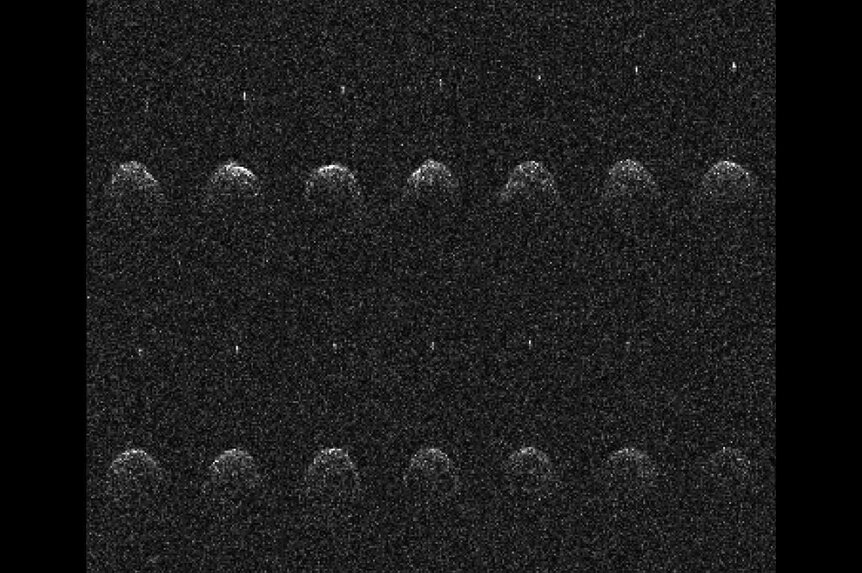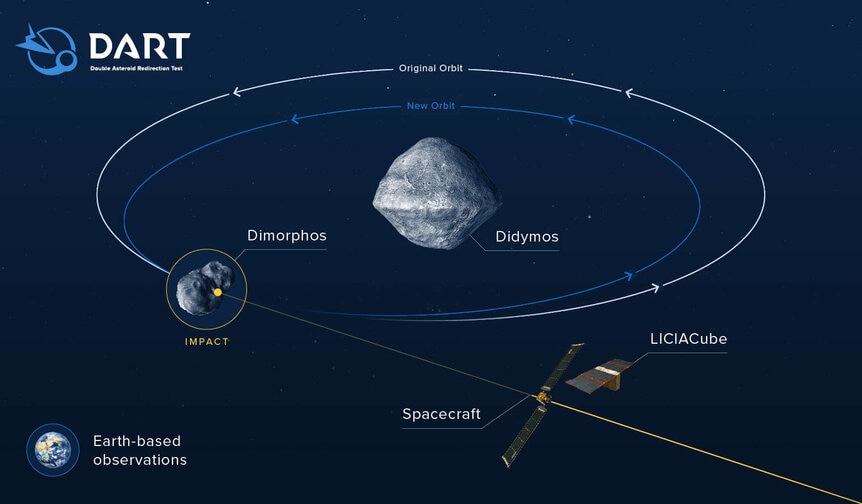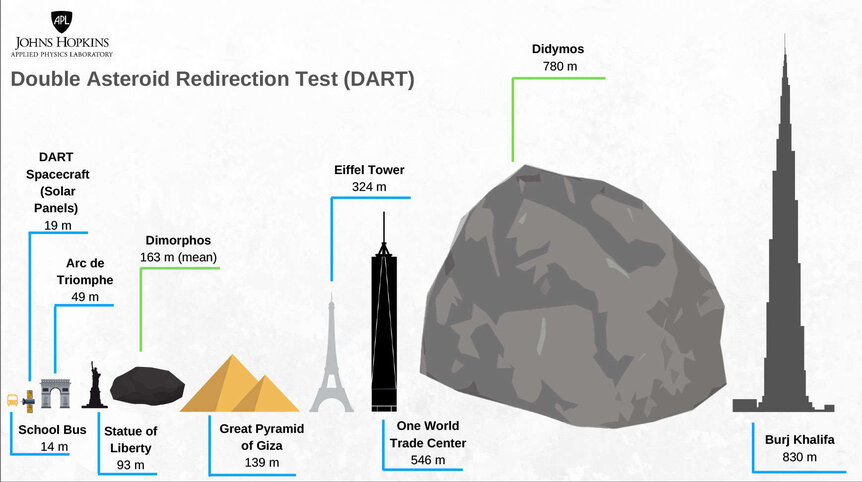Create a free profile to get unlimited access to exclusive videos, sweepstakes, and more!
Will DART slamming into an asteroid's moon cause it to tumble chaotically?

In November 2021, NASA is launching a bold mission to test the technology needed in case we ever have to push a potentially hazardous asteroid off of an Earth-impacting trajectory. Called DART — for Double Asteroid Redirection Test — the 500-kilogram spacecraft will slam into an asteroid’s moon at over 23,000 kilometers per hour, changing the moon’s velocity by a tiny amount.
The idea is that if we ever find an asteroid headed our way, a future DART-like spacecraft can hit it and change its speed enough that, over time, it will miss Earth.
A new paper just published, interestingly, notes that the impact could have a previously unforeseen outcome, causing the moon to start tumbling as it orbits the parent asteroid. To be clear, we are in no danger whatsoever from this if it should happen, but it may complicate a future ESA mission that plans to land a pair of small probes on the moon. It may also have longer-term ramifications for the asteroid system.
The asteroid in question is a binary system, a big rock 780 meters wide called Didymos orbited by a smaller 160-meter moon called Dimorphos*. Together they move on an elliptical path that takes them from 150 million to about 340 million miles from the Sun. That orbit potentially brings them within 6 million kilometers of Earth, so they are classified as Potentially Hazardous Asteroids, ones bigger than 140 meters wide that get within 7.5 million km of Earth.
That close an encounter doesn’t happen often (in other words we’re safe from this pair for the foreseeable future), but in October 2022 they will pass less than 11 million km from us, which is decently close. Not by coincidence, that is the date chosen for the DART mission to impact Dimorphos — that way, telescopes on Earth have as clear a view as possible (thought DART will also have a smaller probe that will deploy before impact to watch the whole event and send data to Earth — making this mission all about duos).
Dimorphos orbits Didymos every 11.9 hours. The impact, which should be equivalent to exploding about 3 tons of TNT, is expected to change the orbital velocity of the moon by only about half a millimeter per second, enough to shorten the orbital period by a few minutes. DART will use a camera on board to navigate autonomously, aiming for the moon’s center. This has never been done before but would be critical for any possible future mission to hit an impacting asteroid; the farther away from Earth we hit it the more time it has to move out of the way, and that means commanding it from Earth may be impossible due to light speed delay.
This sort of idea has been around a long time — called a “kinetic impactor”, I mention it in a TED talk I gave a few years back — and was even implemented in the Deep Impact mission that slammed into a small comet in 2005. But DART will test a variety of new technologies that should make such a mission more reliable.
The new research, though, looks at what happens not to the orbit of Dimorphos but to the moon itself. The scientists used both mathematical analysis and computer simulations to see what would happen to the moon’s behavior after impact. What they found is that under many circumstances the moon may start to tumble chaotically. The orbit will only change a little, but the moon itself could start to change its orientation as it orbits. If you’ve ever watched a toy top as it slows, the axis of rotation first starts to make a circle, then right before it stops the axis flails around all over the place. That’s something like what is predicted here, though for the moon it won’t be quite as frantic an event.
It will likely start off slowly, with the moon tipping a bit, but that will grow over time. Because the moon is not a perfect sphere (nothing really is) it will be off-balance due to the impact. It won’t simply just tip over, but start to tumble in a way that’s difficult to predict.
It’s like the tennis racket theorem: You can spin a tennis racket along its long axis, or in a flat spin, but flip it end-over-end and it will tumble, going through a half-spin. This can also be done with a book, or any object that has three different axes of symmetry.
The moon still orbit Didymos just fine, and the combined orbit of the two around the Sun will remain essentially unchanged. But the tumbling could have some interesting effects.
For one the European Space Agency is flying a follow-up mission called Hera to the asteroid. Due to launch in 2024 and arrive in 2026, it will orbit the pair for some time to examine the moon’s orbit very carefully and see how much it was changed by the impact. It will also have two small probes with it that will examine the moon up close and then attempt to land on it. If Diorphos is tumbling that complicates things, making it more difficult to know exactly what the best approach is to minimize landing velocity, and possibly change where the probes land.
In the long run, it could affect the orbit of the moon. Didymos has weak gravity, but it exerts a tidal force on Dimorphos that should tend to align it such that the moon’s long axis points right at Didymos. That may change after impact. If so, the tides will exert a torque on the moon, trying to align it again. There’s a complicated interaction between an object’s spin and its orbit due to tides (for example, Earth’s tides are causing our own Moon to recede from us by about 4 cm per year), so as the tides from Didymos act on Dimorphos the moon might recede or approach its parent, depending on the exact conditions of the tumbling. Although the change will be small, it may be measurable over time (like, many years).
Again, this should have no effect on the orbits of the two around the Sun, so this isn’t putting us in danger of an impact. But it does show that there can be unintended consequences of the impact.
And that’s the whole point of this mission. Certainly it’s to test the tech to make sure we can do this if and when the time comes that an asteroid has us in its crosshairs, but it’s also a good thing to see what else happens when we try it. What if the moon is a rubble pile (which it likely is)? What if DART hits off-center, or slower or faster than predicted, or or or.
If we already knew everything that was going to happen we wouldn’t need to experiment like this. Better to check all this out with a relatively harmless asteroid than have to do it when the planet is on the line.
*Didymos means “twin” in Greek, and Dimorphos means “having two forms”, which represents the orbit will change after impact
Tip o’ the Whipple Shield to Jonathan O’Callaghan, aka @astro_jonny on Twitter, who wrote about this in Technology Review.






























